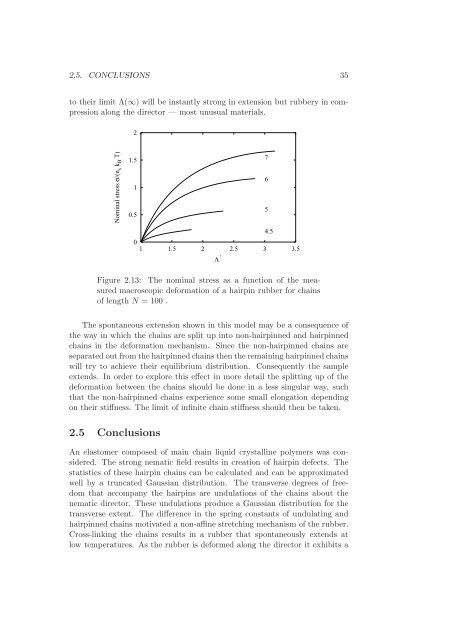Statistical models of elasticity in main chain and smectic liquid ...
Statistical models of elasticity in main chain and smectic liquid ...
Statistical models of elasticity in main chain and smectic liquid ...
Create successful ePaper yourself
Turn your PDF publications into a flip-book with our unique Google optimized e-Paper software.
2.5. CONCLUSIONS 35to their limit Λ(∞) will be <strong>in</strong>stantly strong <strong>in</strong> extension but rubbery <strong>in</strong> compressionalong the director — most unusual materials.2Nom<strong>in</strong>al stress σ/(n s k B T)1.510.576501 1.5 2 2.5 3 3.5Λ ’ 4.5Figure 2.13: The nom<strong>in</strong>al stress as a function <strong>of</strong> the measuredmacroscopic deformation <strong>of</strong> a hairp<strong>in</strong> rubber for cha<strong>in</strong>s<strong>of</strong> length N = 100 .The spontaneous extension shown <strong>in</strong> this model may be a consequence <strong>of</strong>the way <strong>in</strong> which the cha<strong>in</strong>s are split up <strong>in</strong>to non-hairp<strong>in</strong>ned <strong>and</strong> hairp<strong>in</strong>nedcha<strong>in</strong>s <strong>in</strong> the deformation mechanism. S<strong>in</strong>ce the non-hairp<strong>in</strong>ned cha<strong>in</strong>s areseparatedoutfromthehairp<strong>in</strong>nedcha<strong>in</strong>sthentherema<strong>in</strong><strong>in</strong>ghairp<strong>in</strong>nedcha<strong>in</strong>swill try to achieve their equilibrium distribution. Consequently the sampleextends. In order to explore this effect <strong>in</strong> more detail the splitt<strong>in</strong>g up <strong>of</strong> thedeformation between the cha<strong>in</strong>s should be done <strong>in</strong> a less s<strong>in</strong>gular way, suchthat the non-hairp<strong>in</strong>ned cha<strong>in</strong>s experience some small elongation depend<strong>in</strong>gon their stiffness. The limit <strong>of</strong> <strong>in</strong>f<strong>in</strong>ite cha<strong>in</strong> stiffness should then be taken.2.5 ConclusionsAn elastomer composed <strong>of</strong> ma<strong>in</strong> cha<strong>in</strong> <strong>liquid</strong> crystall<strong>in</strong>e polymers was considered.The strong nematic field results <strong>in</strong> creation <strong>of</strong> hairp<strong>in</strong> defects. Thestatistics <strong>of</strong> these hairp<strong>in</strong> cha<strong>in</strong>s can be calculated <strong>and</strong> can be approximatedwell by a truncated Gaussian distribution. The transverse degrees <strong>of</strong> freedomthat accompany the hairp<strong>in</strong>s are undulations <strong>of</strong> the cha<strong>in</strong>s about thenematic director. These undulations produce a Gaussian distribution for thetransverse extent. The difference <strong>in</strong> the spr<strong>in</strong>g constants <strong>of</strong> undulat<strong>in</strong>g <strong>and</strong>hairp<strong>in</strong>ned cha<strong>in</strong>s motivated a non-aff<strong>in</strong>e stretch<strong>in</strong>g mechanism <strong>of</strong> the rubber.Cross-l<strong>in</strong>k<strong>in</strong>g the cha<strong>in</strong>s results <strong>in</strong> a rubber that spontaneously extends atlow temperatures. As the rubber is deformed along the director it exhibits a
















